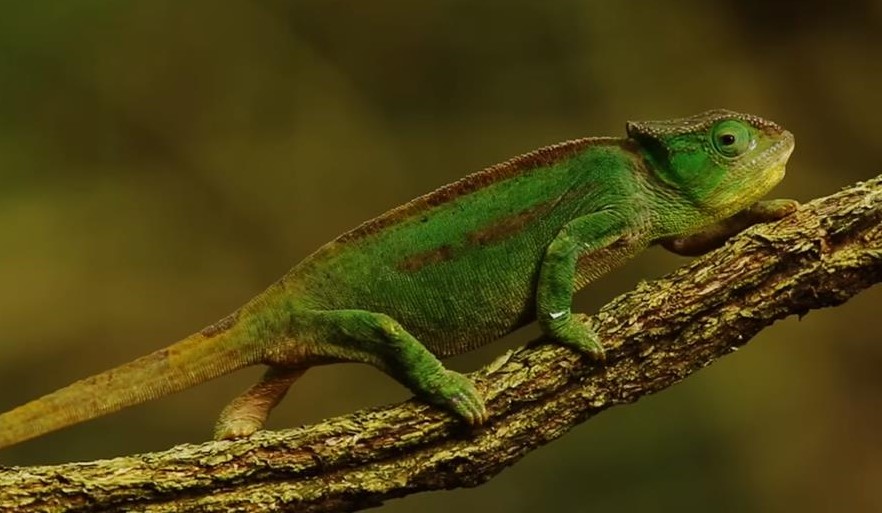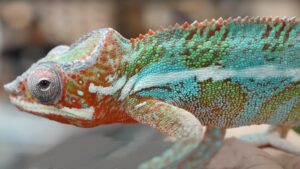Chameleons prefer cages with ample foliage, climbing branches, and temperature gradients. They thrive in environments that mimic their natural habitats.
Creating the ideal environment for a chameleon means ensuring their enclosure feels like a slice of the wild. These adaptive creatures need a comfortable space to exhibit their natural behaviors, like climbing and camouflaging. With vertical space for climbing and a variety of live plants, a best chameleon’s cage can become a sanctuary that promotes both physical and mental health.
A serene mix of basking spots and cooler, shaded areas allows them to regulate their body temperature as they would in nature. Additionally, maintaining proper humidity levels is critical for their hydration and overall well-being. By paying attention to these details, you craft not just a cage, but a home – a place where your chameleon can thrive in health and happiness.
Introducing The Chameleon’s World
Imagine stepping into the shoes—or should we say, scales—of a chameleon. This article peels back the leaves on what makes a chameleon’s cage a cozy home. Chameleons are remarkable creatures with specific needs. Understanding their preferences helps create a thriving environment for these colorful friends.
Natural Habitat Insights
Chameleons flourish in diverse, natural environments. They originate from rainforests, deserts, and grasslands. Common to these habitats are ample foliage, branches for climbing, and varied temperatures. We replicate this in captivity to make chameleons feel at home. Here’s a quick look at their natural settings:
- Temperature: Warm during the day; cooler at night
- Lighting: Bright, mimicking sunlight patterns
- Vegetation: Plenty for hiding and climbing
- Humidity: High, to help with skin and respiratory health
Captivity Vs. Wild: Adapting Spaces
Mimicking a chameleon’s wild habitat in captivity is key to their happiness. A well-structured cage includes all the elements of their natural environment. Here’s what to consider:
| Element | Wild Habitat | Captive Environment |
|---|---|---|
| Space | Expansive areas to explore | Large, airy cages with room to roam |
| Plants | Native flora for shelter | Non-toxic plants and vines |
| Climate Control | Natural temperature cycles | Regulated heating and cooling |
| Humidity | Moist surroundings | Humidifiers or misters |
Carefully selecting each component of the cage ensures a chameleon remains active, healthy, and stress-free. Chameleons thrive when their world reflects the wild, filled with love and the right kind of leafy abode.
Essential Elements Of A Chameleon Habitat
Crafting the ideal home for a chameleon is much like painting a masterpiece. It requires attention to detail, understanding the subject, and patience. A chameleon’s cage is their sanctuary, where they can thrive, explore, and feel secure. To achieve this, certain essential elements must come together harmoniously. Let’s explore the key ingredients that create a perfect habitat for these colorful creatures.
Sizing Up: Cage Dimensions
A chameleon’s cage must be spacious enough to simulate their natural environment. This includes ample room for movement, exercise, and exploration. A tall and wide cage is necessary; think vertical space over horizontal.
- For small to medium chameleons, a minimum size of 24″ x 24″ x 36″ (W x D x H) is essential.
- For larger species, aim for cages starting at 36″ x 36″ x 48″ (W x D x H).
Always choose the largest cage your space can accommodate to give your chameleon a healthy and enjoyable life.
Branching Out: Climbing Structures
Chameleons are natural climbers. They love to perch, bask, and observe their surroundings from a height. Incorporating climbing structures is non-negotiable for their well-being.
- Include a variety of branches, vines, and bamboo sticks.
- Ensure they are secure and sturdy enough to support the chameleon’s weight.
- The arrangement should allow easy movement and ample options for resting spots.
Leafy Retreats: Foliage And Plants
Chameleons seek comfort in the seclusion that leaves and plants offer. Live plants not only enhance the enclosure’s aesthetics but also maintain humidity and provide hiding spots.
- Select non-toxic plant varieties such as Ficus, Pothos, or Hibiscus.
- Ensure plants are well-rooted to withstand climbing activities.
- Artificial foliage can supplement real plants for additional cover and visual appeal.
Creating A Microclimate
Chameleons thrive in environments that mimic their natural habitat. A microclimate in their cage creates the perfect home for these colorful creatures. This miniature world changes just like the outdoors but on a smaller scale. Basking in warm sunshine or hiding in cool shade, species-appropriate environments help chameleons stay healthy and happy.
Balancing Temperatures
Just like a day in the wild, chameleons need a range of temperatures. A thermal gradient allows these cold-blooded animals to regulate body heat by moving around. Include a heating lamp for a warm zone and cooler areas away from the heat.
- Basking Area: Spot for soaking up warmth
- Cool Zone: Retreat from the heat
Humidity Havens
Chameleons are from humid forests and need moist air. Hydration is vital for these reptiles and aids in shedding their skin. Use misters or foggers to keep humidity levels consistent. Also, live plants in the enclosure add to the moisture and make great hiding spots.
| Feature | Benefit |
|---|---|
| Automatic Misters | Consistent moisture |
| Live Plants | Natural humidity |
The Importance Of Ventilation
Good air flow prevents mold and removes stale air. Use a cage with screened sides for optimal ventilation. This stops the air from becoming too heavy or damp. Fresh air is a must for a healthy chameleon. Ventilation supports a stable environment avoiding sudden temperature drops or spikes.
Let There Be Light
Chameleons are unique reptiles with specific needs, and lighting is key to their health and happiness. In the wild, these colorful creatures depend on the sun not just for warmth but also for ultraviolet (UV) rays. Owners must replicate this environment to keep their pet thriving.
A proper lighting setup in a chameleon’s cage helps simulate their natural habitat. This encourages regular behavior and promotes physiological well-being. Here’s what they need:
Sunlight And Uvb Needs
Real sunlight is the best source of UV rays, which helps chameleons synthesize Vitamin D3, crucial for bone health. Sunlight also regulates their circadian rhythm. Here are the key points:
- Direct exposure to unfiltered day sunlight is ideal.
- UVB lighting is necessary for chameleons that don’t get enough natural sunlight.
- 12-hour light cycles mimic their natural environment.
Artificial Lighting Options
When natural light isn’t available, artificial lighting provides UVB and warmth. Let’s look at the options:
| Lighting Type | Benefits |
|---|---|
| Linear fluorescent bulbs | Evenly distribute UVB over a wider area. |
| Compact fluorescent bulbs | Good for smaller cages or focusing light in one area. |
| Mercury vapor bulbs | Provide both UVB and heat. |
Chameleons also need a nighttime drop in temperature. This means turning off bright lights and using a low-wattage heat source if needed.
The Chameleon’s Dining Experience
The Chameleon’s Dining Experience is akin to an art exhibit within the confines of their lush habitat. Understanding the nuances of what chameleons enjoy as part of their meals ensures they not only survive, but thrive. For a chameleon, varied and naturalistic elements within their cage allow for a dining routine that mirrors their wild instincts.
Feeding Stations
Strategic placement of feeding stations plays a vital role in a chameleon’s health and well-being. A thoughtful setup comprises multiple platforms, creating an engaging environment for them to ‘hunt’ their food. Consider these elements for an optimal feeding station:
- Elevated platforms mimic tree branches, encouraging climbing.
- Leafy green cover offers security and comfort.
- Non-toxic plants provide natural hiding spots for insects.
Watering Techniques For Hydration
Chameleons don’t drink from water bowls. They prefer droplets on leaves, simulating rain. The misting technique is critical for their hydration and overall health. Here’s how to keep your chameleon hydrated:
- Daily misting of the enclosure to create water droplets.
- Include a drip system that allows water to trickle on foliage.
- Monitor humidity levels with a hygrometer to ensure a humid environment.
Regularly clean the water systems to prevent bacteria growth, safeguarding your chameleon’s health.
Safety And Comfort Measures
Creating a safe and cozy home for a chameleon is key to their happiness. These unique reptiles need an environment that mirrors their natural habitat. This means lots of space, greenery, and spots to hide. Just as important is making sure that there are no dangers. Safety and comfort go hand in hand here. Let’s explore how to make the perfect cage for your colorful friend.
Avoiding Hazards
Chameleons are curious climbers, but not all adventures are good for them. Their cages must be free of dangerous items. This includes sharp edges, loose substrates, and hazardous plants. To ensure safety, follow these steps:
- Check all décor for sharp points that might harm your pet.
- Select substrate wisely. Large particles can lead to choking if ingested.
- Confirm plants are non-toxic. Some common plants can be poisonous to these reptiles.
- Secure all climbing structures. Make sure they can support your chameleon’s weight.
Privacy Provisions
Chameleons value their alone time. A stress-free space is a must for their well-being. To give your chameleon a quiet retreat, include these elements:
- Foliage that provides ample cover. Live plants create a natural shelter.
- Multiple hiding spots. Use a combo of branches, leaves, and hide boxes.
- A humid hide. This is a special spot that helps with shedding.
- Keep the cage in a low-traffic area. Too many people can scare your chameleon.
Balance is important. Make sure your chameleon has places to hide but can also bask in the light.
Enrichment For An Engaged Chameleon
Chameleons thrive in environments that mimic their natural habitat. To keep your pet chameleon healthy and happy, its enclosure should be more than just a space to live – it should be a hub of activity that promotes engagement and stimulation. Discover how to enrich your chameleon’s cage with elements that ensure its life is full of exploration and excitement.
Variety Is The Spice Of Life: Rotation And Stimulation
Just like humans, chameleons value diversity in their daily lives. A static environment can lead to boredom, or worse, stress. By rotating the decor and introducing new plants and branches, you not only spur mental stimulation, but also encourage physical exercise.
| Week 1 | Week 2 | Week 3 | Week 4 |
|---|---|---|---|
| Ficus Plant | Spider Plant | Orchid | Bamboo |
| Driftwood | Bamboo Perch | Vine Structures | Hollow Logs |
Incorporate a variety of hiding spots and basking areas within the cage. This not only enhances their habitat but also provides necessary thermal gradients for their well-being.
Interactive Features
Interactive elements can greatly improve your chameleon’s quality of life. Consider features such as:
- Feeding Ledges: stimulate hunting instincts.
- Misting Systems: mimic rainfall, integral for hydration.
- Floating Islands: offer a change in perspective.
Introduce occasional treats like live insects that require hunting. This not only provides nutrition but also keeps your chameleon active and engaged.
Create a dynamic, ever-changing world for your chameleon to explore. Always ensure any changes are safe and do not overwhelm your pet. Small steps lead to big rewards in ensuring a fulfilling life for your chameleon companion.
Frequently Asked Questions Of What Do Chameleons Like In Their Cage?
What Type Of Plants Do Chameleons Prefer?
Chameleons enjoy leafy plants that create shade and offer hiding spots. They often choose plants like pothos, hibiscus, or ficus. These provide them with a natural environment, allowing for climbing and refuge.
How Should A Chameleon’s Cage Be Set Up?
A chameleon cage should mimic their natural habitat. Include vertical branches for climbing, various plants for hiding, and ensure proper temperature gradient and humidity. A drip system for water is highly beneficial for simulating natural drinking sources.
What Lighting Is Necessary For A Chameleon Cage?
Chameleons require UVB lighting to absorb calcium and maintain health. A high-quality UVB bulb should be placed within their cage, alongside a basking light to create temperature gradients for their thermoregulatory needs.
What Substrate Is Ideal For Chameleons?
For chameleons, it’s best to use a substrate that retains moisture without getting soggy, such as coconut fiber or bark chips. Avoid fine substrates like sand, as they can cause impaction if ingested.
Conclusion
Creating an ideal environment for your chameleon is crucial. Prioritize their comfort with appropriate foliage, climbing options, and regulated humidity. By doing so, your vibrant friend will thrive, displaying vivid colors and active behaviors. Remember, a happy chameleon means a lively and engaging habitat.
Keep these tips in mind and watch your pet enjoy its mini-jungle!


